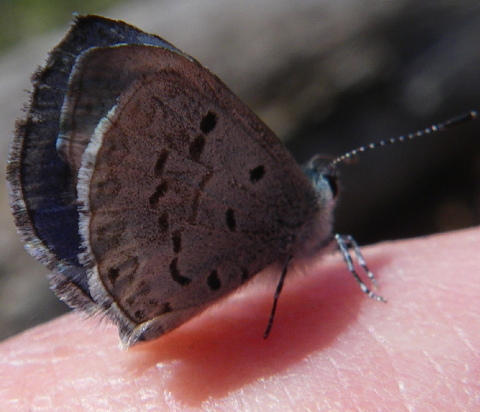Spring Azure Butterfly (Celastrina ladon) at Mass. SouthCoast Bog
Mid-afternoon today, April 21st, as we completed our survey of Grassi Bog on Massachusetts SouthCoast, Turtle Journal’s Sue Wieber Nourse spotted a small, bluish butterfly flittering near the wetlands edge. Â Yes, we are turtle researchers, herpetologists or perhaps even turtlologists. Â But when you spend your life in the field, you make all sorts of discoveries that are not limited by arbitrary boundaries and definitions. Â The bounds of Turtle Journal’s interest encompass the entire scope of Nature. Â So, yes; we were quite taken by this beautiful and delicate little creature. Â (Click on images for enlargement.)
Spring Azure Butterfly (Celastrina ladon)
We snapped pictures of the butterfly as it alit on Don Lewis’ finger with our Pentax Optio W60 underwater camera with a special 1 cm macro lens. Â With all the expensive cameras that Turtle Journal lugs around to capture the world of Nature, nothing has served us better for detailed closeup field photography.
Spring Azure Butterfly (Celastrina ladon)
Checking reference books on our return to Turtle Journal headquarters, we identified the critter as a Spring Azure Butterfly (Celastrina laden). According to Butterflies and Moths of North America, the upper side of males are blue.  Males are most active from mid-afternoon until dusk, the period when we found this specimen.
Spring Azure Butterfly (Celastrina ladon)
The habitat for the Spring Azure Butterfly is described as “openings and edges of deciduous woods, old fields, wooded freshwater marshes and swamps;” a perfect description of the long abandoned and flooded Grassi Bog. Â Now that we have met this delicate butterfly, the Turtle Journal team will keep a sharp eye out for more specimens.





